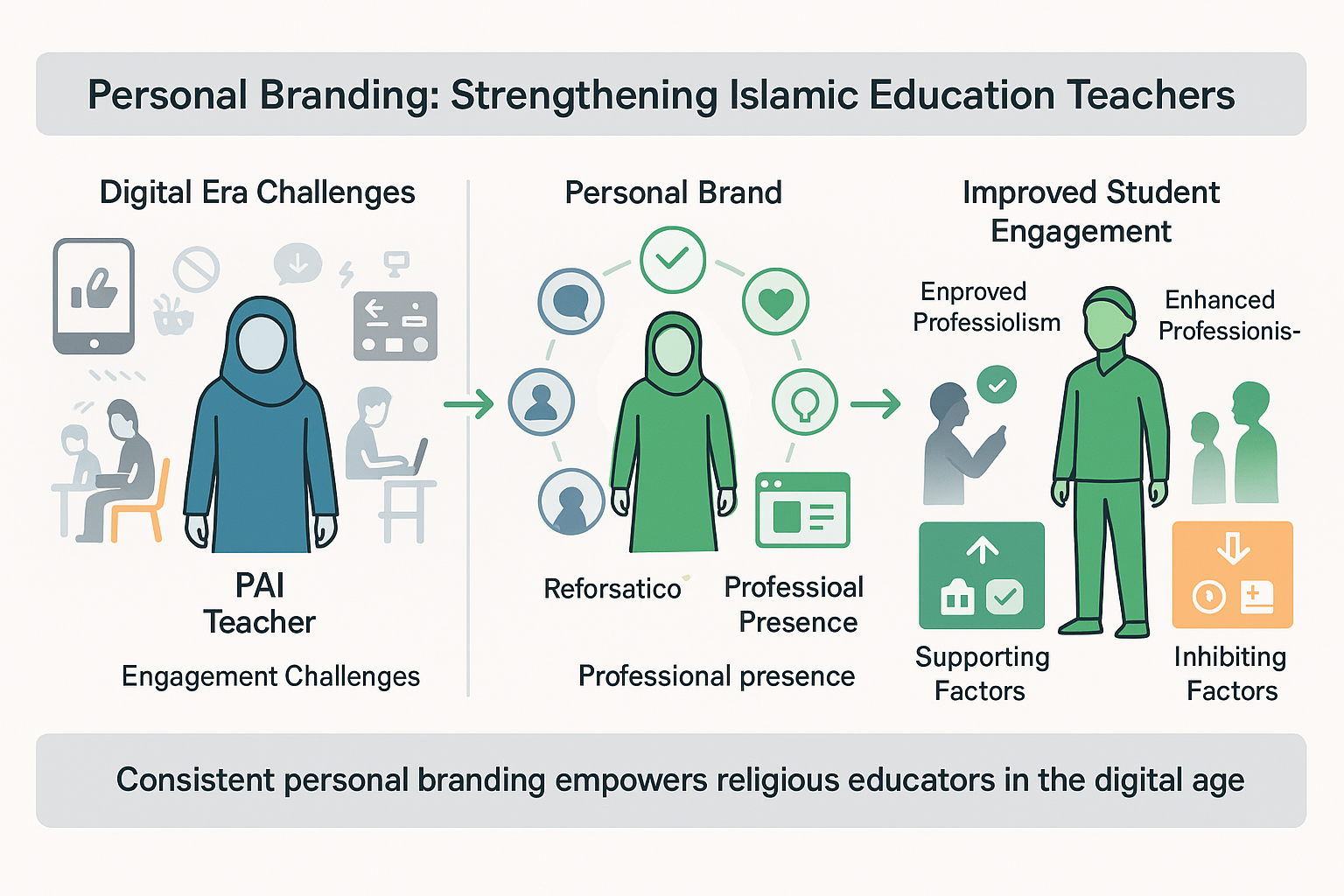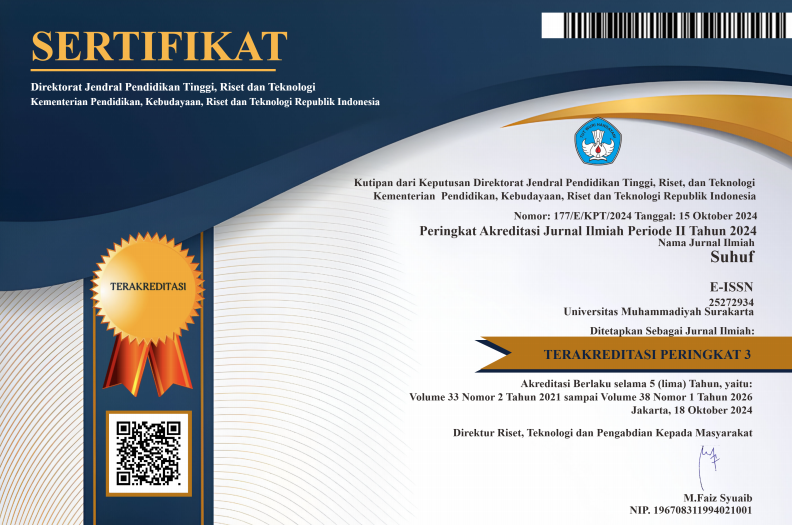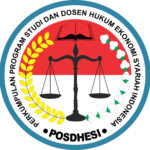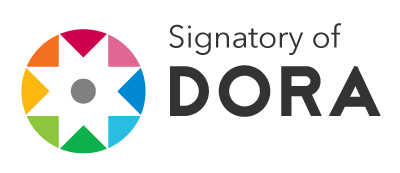Beyond the Classroom: The Role of Personal Branding in Teacher Professional Identity Construction
DOI:
https://doi.org/10.23917/suhuf.v37i1.10008Keywords:
Personal branding, Islamic religious education , Teacher professionalism, Competence in education, Personal integrityAbstract
This study examines the strengthening of the professionalism of Islamic Religious Education (PAI) teachers through the formation of personal branding at SMK Tunas Harapan Plupuh Sragen. PAI teachers have a strategic role in instilling moral and spiritual values in students, but challenges in the digital era make strengthening professionalism very important. Personal branding is seen as a strategy to display a teacher's identity that is inspiring and consistent in attitudes, communication, and actions. The research uses a phenomenological qualitative approach by collecting data through in-depth interviews, observations, and documentation. The results of the study show that authentic and consistent personal branding of PAI teachers can strengthen professionalism, increase confidence, and build harmonious relationships with students and the school environment. Supporting factors include support for the school environment, spiritual and leadership competency standards, and the use of social media. Meanwhile, the inhibiting factors are time limitations, lack of training, and understanding of the concept of personal branding. These findings make an important contribution to the development of a contextual and reflective model for PAI teacher professionalism coaching.
Downloads
References
[1] M. Judrah, A. Arjum, H. Haeruddin, and M. Mustabsyirah, “Peran Guru Pendidikan Agama Islam Dalam Membangun Karakter Peserta Didik Upaya Penguatan Moral [The Role of Islamic Religious Education Teachers in Building Students’ Character as an Effort to Strengthen Morality],” J. Instr. Dev. Res., vol. 4, no. 1, pp. 25–37, (in Indonesia), 2024, doi: https://doi.org/10.53621/jider.v4i1.282.
[2] K. Khairunnisa, M. Vedira, C. Charles, and A. R. Pratama, “Guru Profesional dalam Perspektif Al-Qur’an dan UU NO 14 Tahun 2005: Membangun Generasi Rabbani [Professional Teachers from the Perspective of the Qur’an and Law No. 14 of 2005: Building a Rabbani Generation],” Educ. Achiev. J. Sci. Res., vol. 5, no. 3, pp. 1365–1378, (in Indonesia), 2024, doi: https://doi.org/10.51178/jsr.v5i3.2195.
[3] Muhaimin, Pengembangan kurikulum pendidikan agama Islam: Di sekolah, madrasah, dan perguruan tinggi. Yogyaka: RajaGrafindo Persada, 2005.
[4] C. Kaputa, URA brand: How smart people brand themselves for business success. California: Davies-Black Publishing, 2005. [Online]. Available: https://www.defence.lk/upload/ebooks/U R a Brand.pdf
[5] M. Yamin, Strategi pembelajaran berbasis kompetensi. Jakarta: Gaung persada press, 2005.
[6] C. Moustakas, Phenomenological research methods. Los Angels: Sage, 1994. [Online]. Available: https://books.google.co.id/books?hl=en&lr=&id=QiXJSszx7-8C&oi=fnd&pg=PA1&dq=Moustakas,+C.+(1994).+Phenomenological+Research+Methods.+Sage+Publications.&ots=PyLavZ_ZOp&sig=2kG5rg2O0bUU-mQYVt2EGsgfDDI&redir_esc=y#v=onepage&q=Moustakas%2C C. (1994). Phenomenological Research Methods. Sage Publications.&f=false
[7] S. Sugiyono, Metode Penelitian Pendidikan Pendekatan Kualitatif, Kuantitatif dan R & D. Bandung: Alfabeta, 2018.
[8] J. W. Creswell and C. N. Poth, Qualitative inquiry and research design: Choosing among five approaches. Los Angels: Sage publications, 2016. [Online]. Available: https://books.google.co.id/books?id=DLbBDQAAQBAJ&dq=Creswell,+J.+W.+(2015).+Qualitative+Inquiry+and+Research+Design:+Choosing+Among+Five+Approaches.+Sage+Publications.&lr=&source=gbs_navlinks_s
[9] M. Q. Patton, Qualitative evaluation and research methods. Los Angels: Sage, 1990.
[10] M. C. Welagedara, Crafting Your Educational Identity: The Crucial Role of Personal Branding in Modern Pedagogy. 2024. [Online]. Available: https://library.nie.ac.lk/wp-content/uploads/2024/11/RESC-2023-Ebook-FC.pdf#page=41
[11] S. E. Rosnaini Daga, Personal Branding: Bagaimana Mendefinisikan Diri Dan Membangun Citra Untuk Kehidupan Yang Lebih Baik. Penerbit Adab, 2025.
[12] J. S. Davis, Building a professional teaching identity on social media: A digital constellation of selves. German: Springer, 2016. [Online]. Available: https://books.google.co.id/books?hl=en&lr=&id=USElDQAAQBAJ&oi=fnd&pg=PR7&dq=Beyond+the+Classroom:+The+Role+of+Personal+Branding+in+Teacher+Professional+Identity+Construction&ots=XYe161-qaZ&sig=S3yLlKkM1aeFNg_KfuJ22lkPyQg&redir_esc=y#v=onepage&q&f=false
[13] R. E. Brandabur, “Personal branding of a teacher-an approach into e-educational environment,” in Conference proceedings of» eLearning and Software for Education «(eLSE), Carol I National Defence University Publishing House, 2012, pp. 44–49. [Online]. Available: https://www.ceeol.com/search/article-detail?id=41681
[14] D. Beijaard and P. C. Meijer, “Developing the personal and professional in making a teacher identity,” in The SAGE handbook of research on teacher education, vol. 1, London: SAGE Publications Ltd, 2017, pp. 177–192. [Online]. Available: https://www.torrossa.com/en/resources/an/5018786#page=226
[15] Á. Calanchez Urribarri et al., “Personal Branding and Positioning in the Scientific and Student Community: A Study on Peruvian University Teachers,” Przestrz. Społeczna (Social Space), vol. 23, no. 3, pp. 35–75, 2023, doi: https://socialspacejournal.eu/menu-script/index.php/ssj/article/view/247.
[16] D. Beijaard, P. C. Meijer, and N. Verloop, “Reconsidering research on teachers’ professional identity,” Teach. Teach. Educ., vol. 20, no. 2, pp. 107–128, 2004, doi: https://doi.org/10.1016/j.tate.2003.07.001.
[17] A. Fox and T. Bird, “The challenge to professionals of using social media: Teachers in England negotiating personal-professional identities,” Educ. Inf. Technol., vol. 22, pp. 647–675, 2017, doi: https://doi.org/10.1007/s10639-015-9442-0.
[18] P. P. Somani, “Crafting an Authentic Narrative Exploring the Dynamics of Personal Branding in the Contemporary Academic Landscape,” in Developing Managerial Skills for Global Business Success, IGI Global Scientific Publishing, 2025, pp. 93–108. doi: https://doi.org/10.4018/979-8-3693-3057-9.ch006.
[19] M. A. M. Thomas and N. Mockler, “Alternative routes to teacher professional identity: Exploring the conflated sub-identities of Teach For America corps members,” Educ. Policy Anal. Arch., vol. 26, p. 6, 2018, doi: https://doi.org/10.14507/epaa.26.3015.
[20] D. Beijaard, N. Verloop, and J. D. Vermunt, “Teachers’ perceptions of professional identity: An exploratory study from a personal knowledge perspective,” Teach. Teach. Educ., vol. 16, no. 7, pp. 749–764, 2000, doi: https://doi.org/10.1016/S0742-051X(00)00023-8.
[21] H. Nejadghanbar, J. Song, and G. Hu, “English language teachers’ emotional vulnerability in the era of self‐branding on social media,” TESOL Q., vol. 58, no. 4, pp. 1734–1760, 2024, doi: https://doi.org/10.1002/tesq.3312.
[22] M. Jephcote and J. Salisbury, “Further education teachers’ accounts of their professional identities,” Teach. Teach. Educ., vol. 25, no. 7, pp. 966–972, 2009, doi: https://doi.org/10.1016/j.tate.2009.05.010.
[23] V. V Mantulenko, E. Z. Yashina, and S. I. Ashmarina, “Personal brand of university teachers in the digital age,” in International Scientific Conference “Digital Transformation of the Economy: Challenges, Trends, New Opportunities,” Springer, 2019, pp. 62–70. doi: https://doi.org/10.1007/978-3-030-27015-5_8.
[24] H. P. Widodo, F. Fang, and T. Elyas, “The construction of language teacher professional identity in the Global Englishes territory:‘we are legitimate language teachers,’” Asian Englishes, vol. 22, no. 3, pp. 309–316, 2020, doi: https://doi.org/10.1080/13488678.2020.1732683.
[25] E. P. Gracia, R. S. Rodríguez, and A. P. Pedrajas, “Teachers’ professional identity construction: A review of the literature,” Profesorado, Rev. Currículum y Form. del Profr., vol. 26, no. 1, pp. 371–393, 2022, doi: https://doi.org/10.30827/profesorado.v26i1.13211.
[26] S. P. Vallas and A. Christin, “Work and identity in an era of precarious employment: How workers respond to ‘personal branding’ discourse,” Work Occup., vol. 45, no. 1, pp. 3–37, 2018, doi: https://doi.org/10.1177/0730888417735662.
[27] S. Gorbatov, S. N. Khapova, and E. I. Lysova, “Personal branding: Interdisciplinary systematic review and research agenda,” Front. Psychol., vol. 9, p. 2238, 2018, doi: https://doi.org/10.3389/fpsyg.2018.02238.
[28] M. Khedher, “Conceptualizing and researching personal branding effects on the employability,” J. Brand Manag., vol. 26, no. 2, pp. 99–109, 2019, doi: https://doi.org/10.1057/s41262-018-0117-1.
[29] I. Han, “Development of teacher professional identity through problem-based learning programmes,” in The Development of Professional Identity in Higher Education, Routledge, 2024, pp. 11–30. [Online]. Available: https://www.taylorfrancis.com/chapters/edit/10.4324/9781003407133-4/development-teacher-professional-identity-problem-based-learning-programmes-insuk-han
[30] M. W. Shohib, M. Z. Azani, N. L. Inayati, D. Dartim, and A. Nubail, “Islamic Perspective on Organizational Citizenship Behavior Among Academic Staff in Indonesian State Islamic Higher Education: Is It Effective?,” Suhuf Int. J. Islam. Stud., vol. 36, no. 2, pp. 155–169, 2024, doi: https://doi.org/10.23917/suhuf.v36i2.4702.
[31] M. Murjazin, A. Nurhuda, L. Susanti, and Y. S. Azami, “Psychological and Physiological Motives in Humans (Study on Verses of The Qur’an),” Suhuf, vol. 35, no. 1, pp. 30–44, 2023, doi: 10.23917/suhuf.v35i1.22581.

Downloads
Submitted
Accepted
Published
How to Cite
Issue
Section
License
Copyright (c) 2025 Arilana Nur Izi, Intan Dian Saputri , Diah Eka Sulistia Rini , F Fahrudin , Zuhrufa Redina Izza

This work is licensed under a Creative Commons Attribution 4.0 International License.


















